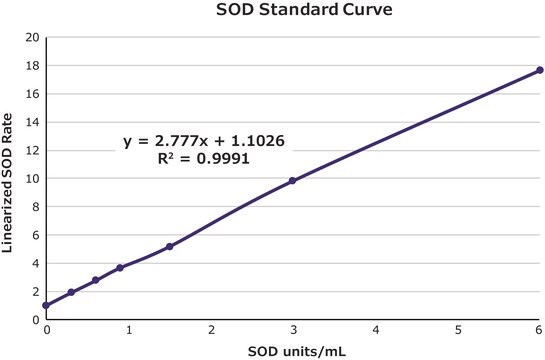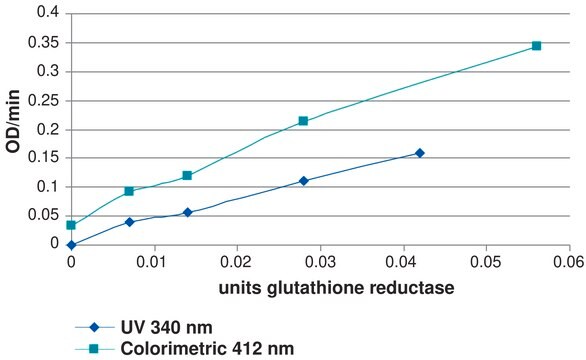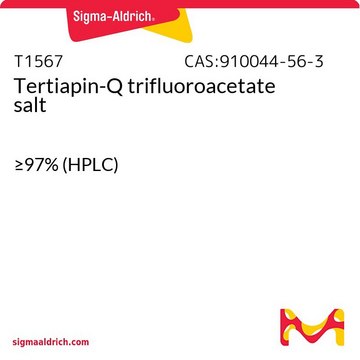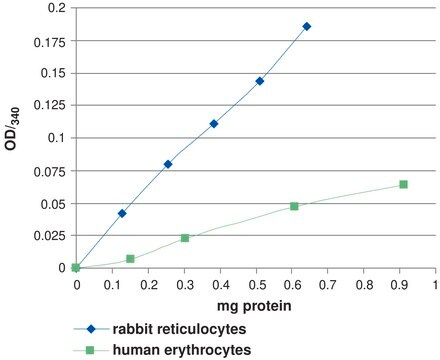おすすめの製品
使用法
sufficient for 100 tests
品質水準
メーカー/製品名
Calbiochem®
保管条件
do not freeze
protect from light
assay range
sensitivity: 5.0 μM
(RSH)
入力
sample type cell lysate
sample type cell lysate
sample type tissue homogenate(s)
sample type tissue homogenate(s)
検出方法
colorimetric
輸送温度
wet ice
保管温度
2-8°C
詳細
A spectrophotometric assay kit that is specific for reduced glutathione (GSH) or total mercaptans. Absorbance is read at ~400 nm for GSH and ~356 nm for total mercaptens.
Note: 1 T = 1 test.
Oxidative stress occurs in most, if not all, human diseases. Our understanding of the role played by reactive oxygen species in the progression of pathological changes is still evolving. Convenient, accurate and reproducible methodologies to measure oxidative stress parameters have been lacking. Glutathione (γ-glutamylcysteinylglycine or GSH) is a naturally occuring tripeptide whose nucleophilic and reducing properties play a central role in metabolic pathways, as well as in the antioxidant system of most aerobic cells. GSH plays a critical role as a coenzyme with a variety of enzymes including, glutathione peroxidase, glutathione S-transferase, and thiol transferase. GSH also plays major roles in drug metabolism, calcium metabolism, the γ-glutamyl cycle, blood platelet, and membrane functions. In addition, GSH is crucial to a variety of life processes, including the detoxification of xenobiotics, maintenance of the -SH level of proteins, thiol-disulfide exchange, removal of hydroperoxides and free radicals, and amino acid transport across membranes. Physiological values of intracellular GSH generally range from 1 to 10 mM. Although many methods have been described for the assay of GSH, the reliable ones are labor intensive and not easy to use.
構成
A Chromogen, 30% NaOH, Buffer, and a user protocol.
警告
Toxicity: Multiple Toxicity Values, refer to MSDS (O)
規格
Assay Time: 1.5 h
原理
The Calbiochem® Glutathione Assay Kit makes it possible to assay for glutathione with only one sampling and one colorimetric measurement. A modification of this method makes it possible to assay other mercaptans. This alternate protocol is based on the measurement of substitution products that absorb maximally at 356 nm in the absence of reagent R2. Due to its ease of use, this method is well adapted for the quantification of glutathione and total mercaptans in a large number of biological samples. The main advantage of the method is that it does not require any enzyme as a reagent.
調製ノート
Erythrocyte Lysate
1. Centrifuge a minimum of 500 l of whole blood at 2500 X g at 4°C for 5 min.
2. Discard plasma supernatant. If not assayed immediately, store erythrocyte pellet at -70°C (erythrocyte pellet can be stored at -70°C for 15 days).
3. Resuspend erythrocyte pellet in 4 volumes of MPA working solution, 0-4°C.
4. Thoroughly mix and centrifuge at 3000g at 4°C for 10 min.
5. Collect the upper clear aqueous layer and keep at 0-4°C for the assay (within 1 h).
Liver Homogenates
1. Wash tissue in 0.9% NaCl solution.
2. Blot tissue on paper and weigh.
3. Mince tissue in ice-cold MPA working solution.
4. Homogenize minced tissue.
5. Centrifuge homogenate at 3000 x g, 4°C for 10 min.
6. Collect the upper clear aqueous layer* and keep at 0-4°C for the assay (within 1 h).
*Cloudy supernatant should be filtered through 0.2 m filters.
Hepatocyte Lysates
1. Resuspend hepatocyte* pellet, from rats or mice, in 500 l of ice-cold MPA working solution.
2. Homogenize cell suspension.
3. Centrifuge homogenate at 3000 x g, 4°C for 10 min.
4. Collect the upper clear aqeous layer and keep at 0-4°C for the assay (within 1 h).
*Approximately 2.5-3.5 x 106 cells are used (5-8 mg of total protein).
1. Centrifuge a minimum of 500 l of whole blood at 2500 X g at 4°C for 5 min.
2. Discard plasma supernatant. If not assayed immediately, store erythrocyte pellet at -70°C (erythrocyte pellet can be stored at -70°C for 15 days).
3. Resuspend erythrocyte pellet in 4 volumes of MPA working solution, 0-4°C.
4. Thoroughly mix and centrifuge at 3000g at 4°C for 10 min.
5. Collect the upper clear aqueous layer and keep at 0-4°C for the assay (within 1 h).
Liver Homogenates
1. Wash tissue in 0.9% NaCl solution.
2. Blot tissue on paper and weigh.
3. Mince tissue in ice-cold MPA working solution.
4. Homogenize minced tissue.
5. Centrifuge homogenate at 3000 x g, 4°C for 10 min.
6. Collect the upper clear aqueous layer* and keep at 0-4°C for the assay (within 1 h).
*Cloudy supernatant should be filtered through 0.2 m filters.
Hepatocyte Lysates
1. Resuspend hepatocyte* pellet, from rats or mice, in 500 l of ice-cold MPA working solution.
2. Homogenize cell suspension.
3. Centrifuge homogenate at 3000 x g, 4°C for 10 min.
4. Collect the upper clear aqeous layer and keep at 0-4°C for the assay (within 1 h).
*Approximately 2.5-3.5 x 106 cells are used (5-8 mg of total protein).
保管および安定性
Upon arrival store the entire kit contents at 4°C.
• All solutions of reagents and buffer have been tightly sealed and are stable if properly stored between 4°C. Do Not Freeze. Protect from light.
• After removing the required amount of each reagent for immediate use, all bottles should be tightly closed and stored between 2-4°C. Do not leave the reagent bottles open or at room temperature.
• All solutions of reagents and buffer have been tightly sealed and are stable if properly stored between 4°C. Do Not Freeze. Protect from light.
• After removing the required amount of each reagent for immediate use, all bottles should be tightly closed and stored between 2-4°C. Do not leave the reagent bottles open or at room temperature.
アナリシスノート
Measurement of Total Mercaptans (RSH): Assay at 356 nm
The Calbiochem Glutathione Assay Kit can be used for the measurement of other mercaptans (RSH), which include GSH. The assay is carried out in the absence of reagent R2 at 356 nm. The absorbance at 356 nm is a linear function of [RSH] concentration in the sample, but it is not GSH-specific. If the sample essentially contains GSH and a single other mercaptan i.e., N-acetylcysteine, these two mercaptans can be assayed by using the same single sample for two measurements. The first measurement is made at 356 nm before the addition of reagent R2 as described below, and the second measurement is made, after the addition of R2, at 400 nm.
Adjust the spectrophotometer absorbance to zero at 356 nm with buffer only (solution 3). The reaction mixture is prepared as in Section 3, with the omission of step 4. The absorbance (A) is measured at 356 nm.
A standard curve must be prepared with the corresponding mercaptan in Table 2, to calculate the concentration. Figure 2 gives two examples of standard curves obtained with glutathione and Nacetylcysteine at 356 nm.
GSH Concentration
The calculation is based on the following equation:
[GSH] = {(A-A0)/(E x l)} x D
where:
[GSH] is the initial glutathione concentration in the sample, expressed as molar concentration.
A and A0 are the absorbances measured in the presence and in the absence of sample, respectively.
E is the apparent molar extinction coefficient of the product measured at 400 nm.
l is the optical path (cm).
D is the dilution factor of the sample.
Total Mercaptan Concentration
The calculation is based on the modified version of the equation used for GSH:
[total RSH] = { (A - A0) / (E x I) } x D
where :
[total RSH] is the concentration of total mercaptan in the sample.
A and A0 are the absorbances measured in the presence and in the absence of sample, respectively.
E is the apparent molar extinction coefficient of the product measured at 356 nm.
I is the optical path (cm).
D is the dilution factor of the sample.
Note:
The Calbiochem Glutathione Assay Kit can be used for the measurement of other mercaptans (RSH), which include GSH. The assay is carried out in the absence of reagent R2 at 356 nm. The absorbance at 356 nm is a linear function of [RSH] concentration in the sample, but it is not GSH-specific. If the sample essentially contains GSH and a single other mercaptan i.e., N-acetylcysteine, these two mercaptans can be assayed by using the same single sample for two measurements. The first measurement is made at 356 nm before the addition of reagent R2 as described below, and the second measurement is made, after the addition of R2, at 400 nm.
Adjust the spectrophotometer absorbance to zero at 356 nm with buffer only (solution 3). The reaction mixture is prepared as in Section 3, with the omission of step 4. The absorbance (A) is measured at 356 nm.
A standard curve must be prepared with the corresponding mercaptan in Table 2, to calculate the concentration. Figure 2 gives two examples of standard curves obtained with glutathione and Nacetylcysteine at 356 nm.
GSH Concentration
The calculation is based on the following equation:
[GSH] = {(A-A0)/(E x l)} x D
where:
[GSH] is the initial glutathione concentration in the sample, expressed as molar concentration.
A and A0 are the absorbances measured in the presence and in the absence of sample, respectively.
E is the apparent molar extinction coefficient of the product measured at 400 nm.
l is the optical path (cm).
D is the dilution factor of the sample.
Total Mercaptan Concentration
The calculation is based on the modified version of the equation used for GSH:
[total RSH] = { (A - A0) / (E x I) } x D
where :
[total RSH] is the concentration of total mercaptan in the sample.
A and A0 are the absorbances measured in the presence and in the absence of sample, respectively.
E is the apparent molar extinction coefficient of the product measured at 356 nm.
I is the optical path (cm).
D is the dilution factor of the sample.
Note:
- Do not add reagents R1 and R2 in reverse order.
- The temperature, (25 ± 3°C), should be kept constant throughout the experiment.
- The final reaction volume (1 ml) should not vary from one measurement to another.
- The absorbance at 400 nm is proportional to glutathione concentration. It is stable for min, provided that the reaction mixture is kept in the dark.
- The sensitivity of the assay for mercaptans at 356 nm is of the same order of magnitude as that of glutathione at 400 nm as shown in Table 2.
Sensitivity: From 30 repeated measurements performed on the control ([RSH] = 0) on the same day, under the same experimental conditions, the detection limit of the assay was 5 µmol/l in the final reaction mixture (spectrophotometric cuvette). For example, using the maximum volume of 300 µl of a sample would therefore give a detection limit for glutathione of about 17 µmol/l.
その他情報
Due to the nature of the Hazardous Materials in this shipment, additional shipping charges may be applied to your order. Certain sizes may be exempt from the additional hazardous materials shipping charges. Please contact your local sales office for more information regarding these charges.
Ji, L.L., and Fu, R. 1992. J. Appl. Physiol.72, 549.
Anderson M.E. 1989. Enzymatic and chemical methods for the determination of
Glutathione; In: Glutathione: chemical, biochemical and medical aspects, Vol. A, Dolphin D., Poulson R. and Avramovic O. Eds., John Wiley and Sons, pp. 339-365.
Dolphin D., et al. 1989. Glutathione: Chemical, Biochemical and Medical Aspects, Vols A & B, J. Wiley and Sons.
Anderson M.E. 1989. Enzymatic and chemical methods for the determination of
Glutathione; In: Glutathione: chemical, biochemical and medical aspects, Vol. A, Dolphin D., Poulson R. and Avramovic O. Eds., John Wiley and Sons, pp. 339-365.
Dolphin D., et al. 1989. Glutathione: Chemical, Biochemical and Medical Aspects, Vols A & B, J. Wiley and Sons.
法的情報
CALBIOCHEM is a registered trademark of Merck KGaA, Darmstadt, Germany
シグナルワード
Danger
危険有害性情報
危険有害性の分類
Eye Dam. 1 - Met. Corr. 1 - Skin Corr. 1A
保管分類コード
8B - Non-combustible corrosive hazardous materials
引火点(°F)
Not applicable
引火点(℃)
Not applicable
適用法令
試験研究用途を考慮した関連法令を主に挙げております。化学物質以外については、一部の情報のみ提供しています。 製品を安全かつ合法的に使用することは、使用者の義務です。最新情報により修正される場合があります。WEBの反映には時間を要することがあるため、適宜SDSをご参照ください。
Jan Code
354102-100T:
試験成績書(COA)
製品のロット番号・バッチ番号を入力して、試験成績書(COA) を検索できます。ロット番号・バッチ番号は、製品ラベルに「Lot」または「Batch」に続いて記載されています。
この製品を見ている人はこちらもチェック
Georgian T Mustata et al.
Diabetes, 54(2), 517-526 (2005-01-29)
We tested the hypothesis that green tea prevents diabetes-related tissue dysfunctions attributable to oxidation. Diabetic rats were treated daily with tap water, vitamins C and E, or fresh Japanese green tea extract. After 12 months, body weights were decreased, whereas
Suh-Ching Yang et al.
The British journal of nutrition, 92(2), 209-215 (2004-08-31)
The purpose of the present study was to evaluate the effects of beta-carotene on the cell viability and antioxidant status of hepatocytes from chronically ethanol-fed rats. Rats in the ethanol group were given an ethanol-containing liquid diet that provided 36
Wang-teng Lin et al.
Acta pharmacologica Sinica, 26(8), 992-999 (2005-07-26)
To assess the effects of L-arginine (L-Arg) supplementation on pulmonary oxidative stress and antioxidant defenses in rats after exhaustive exercise. Rats were randomly divided into four groups: sedentary control (SC), sedentary control with L-Arg treatment (SC+Arg), exhaustive exercise with control
Atul Sahai et al.
American journal of physiology. Gastrointestinal and liver physiology, 287(1), G264-G273 (2004-03-27)
The pathogenesis of nonalcoholic steatohepatitis (NASH) is poorly defined. Feeding mice a diet deficient in methionine and choline (MCD diet) induces experimental NASH. Osteopontin (OPN) is a Th1 cytokine that plays an important role in several fibroinflammatory diseases. We examined
Glutathione Biosynthesis Influences Replicative Longevity in Saccharomyces Cerevisiae.
Sylvie M Van Zandycke et al.
TheScientificWorldJournal, 1, 133-133 (2001-10-17)
ライフサイエンス、有機合成、材料科学、クロマトグラフィー、分析など、あらゆる分野の研究に経験のあるメンバーがおります。.
製品に関するお問い合わせはこちら(テクニカルサービス)






